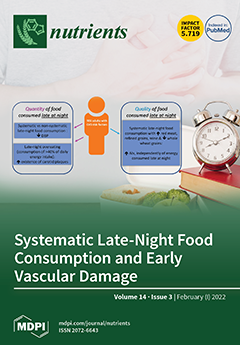Ferrous sulphate (FS) is widely used as an iron supplement to treat iron deficiency (ID), but is known to induce inflammation causing gastric side-effects resulting in poor adherence to supplement regimens. Curcumin, a potent antioxidant, has been reported to suppress inflammation via down
[...] Read more.
Ferrous sulphate (FS) is widely used as an iron supplement to treat iron deficiency (ID), but is known to induce inflammation causing gastric side-effects resulting in poor adherence to supplement regimens. Curcumin, a potent antioxidant, has been reported to suppress inflammation via down regulation of NF-κB. The aim of the present double blind, placebo-controlled randomised trial was to assess whether co-administration of FS with a formulated, bioavailable form of curcumin (HydroCurc™) could reduce systemic inflammation and/or gastrointestinal side-effects. This study recruited 155 healthy participants (79 males; 26.42 years ± 0.55 and 76 females; 25.82 years ± 0.54), randomly allocated to one of five different treatment groups: iron and curcumin placebo (FS0_Plac), low dose (18 mg) iron and curcumin placebo (FS18_Plac), low dose iron and curcumin (FS18_Curc), high dose (65 mg) iron and curcumin placebo (FS65_Plac), and high dose iron and curcumin (FS65_Curc). Completed questionnaires and blood samples were collected from all participants at baseline (day 1), mid-point (day 21), and at end-point (day 42). Results showed a significant reduction in IL-6 in the FS65_Curc group (0.06 pg/mL ± 0.02,
p = 0.0073) between the mid-point and end-point. There was also a significant reduction in mean plasma TNF levels in the FS65_Curc (0.65 pg/mL ± 0.17,
p = 0.0018), FS65_Plac (0.39 pg/mL ± 0.15,
p = 0.0363), and FS18_Curc (0.35 pg/mL ± 0.13,
p = 0.0288) groups from mid-point to end-point. A significant increase was observed in mean plasma TBARS levels (0.10 µM ± 0.04,
p = 0.0283) in the F18_Plac group from baseline to end-point. There was a significant association with darker stools between FS0_Plac vs. FS65_Plac (
p = 0.002, Fisher’s exact test) suggesting that high iron dose in the absence of curcumin leads to darker stools. A reduction in inflammation-related markers in response to co-administering supplemental iron alongside formulated curcumin suggests a reduction in systemic inflammation. This supplementation approach may therefore be a more cost effective and convenient alternative to current oral iron-related treatments, with further research to be conducted.
Full article


